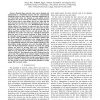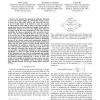104 search results - page 4 / 21 » On Field Size and Success Probability in Network Coding |
BMCBI
2008
13 years 5 months ago
2008
Background: Cellular metabolism is one of the most investigated system of biological interactions. While the topological nature of individual reactions and pathways in the network...
CORR
2010
Springer
13 years 8 days ago
2010
Springer
Random linear network codes can be designed and implemented in a distributed manner, with low computational complexity. However, these codes are classically implemented [1] over fi...
CDC
2009
IEEE
13 years 10 months ago
2009
IEEE
— Given an arbitrary network of interconnected nodes, each with an initial value from a discrete set, we consider the problem of distributively disseminating these initial values...
CORR
2010
Springer
13 years 5 months ago
2010
Springer
We consider the problem of optimally allocating a given total storage budget in a distributed storage system. A source has a data object which it can code and store over a set of s...
INFOCOM
2009
IEEE
13 years 12 months ago
2009
IEEE
Abstract—Delay tolerant Ad-hoc Networks leverage the mobility of relay nodes to compensate for lack of permanent connectivity and thus enable communication between nodes that are...


